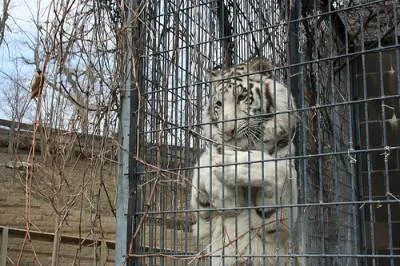
This is how we currently see this most beautiful of wild animals, behind bars, imprisoned. As the photographer says in his caption, "praying tiger". Praying to live a normal life, uncaged free to roam, but we have created a hostile world for wild cats and the Siberian Tiger's existence is at stake. Photo by A. Dawson under a creative commons license.
Introduction
By far the most important aspect of the Siberian Tiger (Panthera tigris altaica) (Amur tiger) is the decline in population of this fantastic big cat.
The White Siberian Tiger is not, as you may know, a separate big cat species (or subspecies) to the orange Siberian Tiger (the classic tiger color and pattern). This superb animal is simply a Siberian tiger with a different colored coat but see below, please. As a result this posting is about the Siberian tiger generally with reference to the genetics of the white Siberian tiger. And before proceeding it it worth mentioning the following.
Note this please: It is argued that all white tigers are mutations from the Bengal tiger, which is not the Siberian tiger. Certainly all white tigers in captivity were for many years tigers breed from a single white Bengal tiger that came from Madhya Pradesh, India in 1951. He was called, Mohan. Mohan was mated with his normal coloured daughter resulting in 4 white cubs and all the white tigers in captivity come from this inbred beginnings.
White tigers in captivity have high coefficients of inbreeding leading to infertility (poor sperm - see Inbreeding and Poor Sperm Quality ) genetic defects and inreased cub mortality. Orange tigers born from later matings are presumably unwanted. It is a massive abuse of this magnificent wildcat. Sometimes these white tiger are cross bred with captive Siberian tigers to produce a hybrid. These offspring could be called hybrid White Siberian tigers. The question remains whether there could be wild white Siberian tigers as the natural mutation occuring in the Bengal tiger (albiet many years ago in respect of the Bengal tiger), could occur in the Siberian tiger and with the population of the Siberian tiger rapidly diminishing there will be an increased risk of inbreeding (see Inbreeding of Wildcats). Inbreeding increases the chance of recessive genes such as the one producing the white tiger becoming apparent. Also you might like to see: Endangered White Tiger.
The difference in the coat coloration and the faint pattern is due to the presence of two recessive alleles (allele = one of a pair of genes) at the same location (locus) on the chromosome (this is called homozygous).
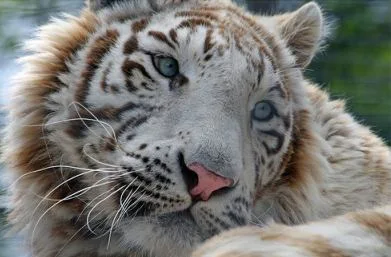
White Siberian Tiger showing the diluted coloration and the brown stripes instead of the very dark brown/black stripes. This cat has blue eyes and a pink nose. Photo by christinatinarobinso
Genetics
The recessive gene dilutes (or inhibits the formation of) the orange color and the dark stripes. It is a mutant recessive gene. In domestic cats mutant genes have resulted in the creation of new cat breeds (as defined by the cat fancy). An example would be dwarf cats (due to a dominant gene) and the American Curl. There are many other examples and you can see them all by going to the main website, Pictures-of-cats.org. If we discovered a tiger with curled ears would we name the animal a different type of tiger? I think not.
As the Wikipedia author says, the recessive gene is not one that produces an albino tiger. In the world of domestic cats (the cat fancy) the inhibitor gene (I) is dominant. Its presence has the effect of reducing the pigmentation that is embedded in each hair shaft. This results in what the cat fancy calls, "silver" coloration.
It is the dilution gene (dd) that is recessive (as signified by the lower case letters). It is found at the dilute locus on the chromosome. When this gene is a mutant version, the pigmentation granules, that are usually evenly distributed throughout the individual hairs, are larger and grouped in clumps and therefore placed unevenly in the hairs. Parts of the individual hairs can have no pigment at all. This gives the impression of a diluted color. A classic case of this can be found in the grey British Shorthair (this cat breed can be many other colors/patterns too). It has to be present in homozygous form (2 alleles at the same locus) to have effect and black becomes blue/grey. It can also be present in cats with the tabby gene as can be seen in this post on cat coats tabby.
The coat is heat sensitive as is the case for pointed domestic cats such as the Siamese cat. This is why the points (the cold extremities) of the Siamese are darker.
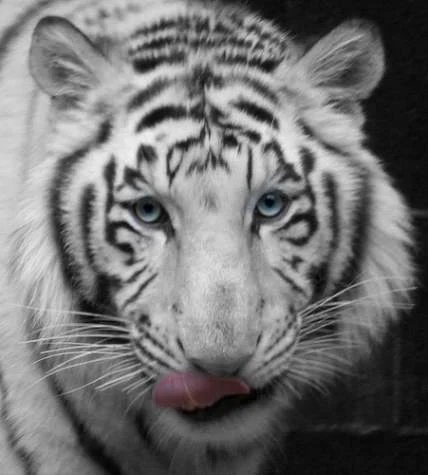
White Siberian Tiger - Photo by A. Dawson under a creative commons license.
Population-poaching-trade-inbreeding
It is claimed that Siberian tigers are the largest and rarest of all the big cats. A big male can weigh a maximum of about 800 lbs and be near 11 feet in length. White tigers generally are on the increase as captive animals. Another probably more frequently encountered white tiger is the Bengal white tiger. White pelage (hair fur and wool of the animal) is more commonly found on the Bengal tiger, a subspecies of the tiger family.
Most (or all/) white tigers are bred in captivity as they are popular with zoo visitors and there are so few left in the wild. As mentioned, they are inbred and inbreeding will increase the chance of producing the phenotype (appearance) of a recessive gene such as the one producing the white coat on this cat but there is the downside of inbreeding depression (weakened immune system, physiological defects and ill health). This hints at commercial gain (in zoo attendance) at the expense of animal welfare.
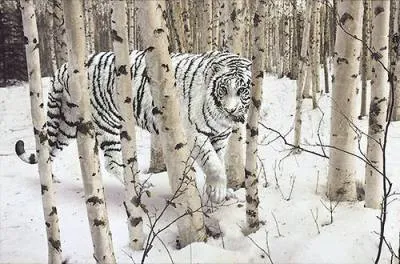
White Siberian tiger. The fact that this is a skillfully made up picture (if I'm wrong - tell me please), is very apt as the current population of this wild cat is highly artificially made up as explained through inbreeding in zoos. Photo by Siberian Tiger.
The white Siberian tiger (if one exists) eats the same prey as the orange Siberian and Bengal tiger. The sharply declining population of the Siberian tiger is due to poaching and habitat loss, essentially. Poaching is in part at least, motivated by the high prices for body parts, which as used in Chinese medicine (tiger bone for example is used in their blighted medicine). Chinese medicine has caused massive damage to important wild species. This problem needs to be addressed by the world wide community. I have rarely seen this issue addressed (except by me) and why not? Most Siberian tigers (orange and white - are there any white ones left in the wild? - people say no) are killed and then exported to China.
Apparently, since 1993 the Chinese Government declared that the use of tiger bone in medicine illegal; obviously words and no action. There has also been a declared intention to put pressure on the Chinese pharmaceutical companies to use substitutes to these animal parts but it would seem to be to no avail. There is a lack of enforcement and commitment plus there is too much money in it. Commerce ultimately runs the world and certainly runs China.
China is ostensibly a member of CITES (Convention on International Trade in Endangered Species of Wild Fauna and Flora). That means China should do all it can to stop the trade of endangered species in their country. Yet there is open evidence that this is not happening.
Has China got a stranglehold on other countries? Probably yes, as China produces cheap goods and the West likes that. China actually is causing many world problems. The West does not need more cheap goods, feeding the insatiable human appetite to own and consume. In addition China has an appalling animal rights record. Many thousands of feral cats have been inhumanly slaughtered to clear the streets for the 2008 Olympics. Some Chinese eat domestic cats. I allege that the Chinese imprison humans for minor offences and many prisoners are executed and their body parts sold for profit to fund the prison system.
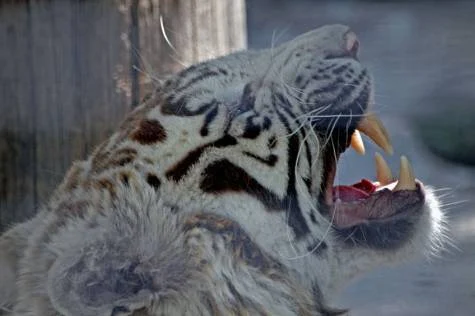
White Siberian Tiger or is this a hybrid Bengal/Siberian tiger? Photo by Photo by christinatinarobinso
Habitat
The habitat of the Siberian tiger is the woods of Russia (Siberia is in Eastern Russia but Google maps does not recognize the word "Siberia" - Primorsk region being one area) and North Korea (link to Google maps) and North Eastern China. As far as I am aware this cat is near extinction (or extinct) in China and North Korea, in the wild. The Siberian Russian pine and broad leaf forests are the last sanctuary probably because of inaccessibility.
However, logging in Russia has had an impact on the population of tigers living in the wild. Fortunately it seems that some trees are less commercially viable to cut down so it is in these areas where the tiger survives as does the prey which it hunts. The Gorbachev era (the end of communism) brought in capitalism which in turn encouraged wider logging and reduction in habitat. It also probably indirectly encouraged the trade with China in Siberian tiger skins and parts as it encouraged entrepreneurs.
Apparently between 334-417 Siberian tigers exist in the Siberian forests. I don't know if there are any white ones. And the experts don't know either despite what one or two people have said in comments.
However, I think it can be safely said that the performing White Siberian tiger in a zoo is the future of the tiger. This is what we have created for this animal. Maybe it's not so bad. I just prefer it a little more natural.
Conclusion
The Siberian tiger generally is critically endangered. Urgent action not words are required. The captive breeding program is tainted by commerce and undermined by inbreeding, which not infrequently results in the birth of cubs with congenital defects. See this video:
This is a horrible but powerful video. What we see is not what is. It never has been............
Sources:
- http://web.fccj.edu
- http://en.wikipedia.org
- http://www.essortment.com
- http://animals.about.com
- http://www.american.edu
- Wild Cats of the World



Very informative, thanks for using a couple of my pictures, quite the honor.
ReplyDeleteHi, thanks for the comment and the pictures. It is good of you to allow their use under a creative commons license.
ReplyDelete"...the White Siberian Tiger's existence is at stake."? You make it sound like it is a race, a subcpecies that is being esterminated in the wild. Look, I appreciate what you're trying to do here, but the white tiger is the cause of imbreeding in captivity. It is not something that should exist at all. Posting things like this for all the world to see makes people think that the people who breed them are doing a good thing for the species but overlook the fact that for every one alive, some 15 to 40 of its siblings were killed because they were the wrong color or had birth defects. They do not exist in the wild! Only in cages, circuses, and zoos- Do not promote the breeding of whtie tigers because their very existance means the sufferage of others.
ReplyDeleteResponse to the last comment. I think that you are incorrect in saying that the cause of the white tiger is due solely to inbreeding in captivity.
ReplyDeleteYes, inbreeding will result in a greater chance of the mutated recessive gene showing but inbreeding also happens in the wild and as the Siberian tiger still exists in the wild a white Siberian tiger could be born in the wild.
White tigers have existed in the wild and are not exclusively found in captivity although as I say they are exploited in captivity and over bred in captivity. I agree that the exploitation is horrific and I despise it.
To say that the white Siberian tiger should not exist at all is wrong as a genetic mutation will occur naturally and therefore bring into existence a white tiger. Who says it should not exist? Are you God?
I disagree with you therefore. I have though made some slight and minor amendments to the post to avoid any misunderstanding.
Thanks for the comment.
I agree with Freddy Fox. God created us to take care of his animals!
ReplyDeleteLet them go. Cant u c he is praying to get out.
ReplyDeleteNever mind that comment. After wachting the video I relized u guys lov animals.
ReplyDelete